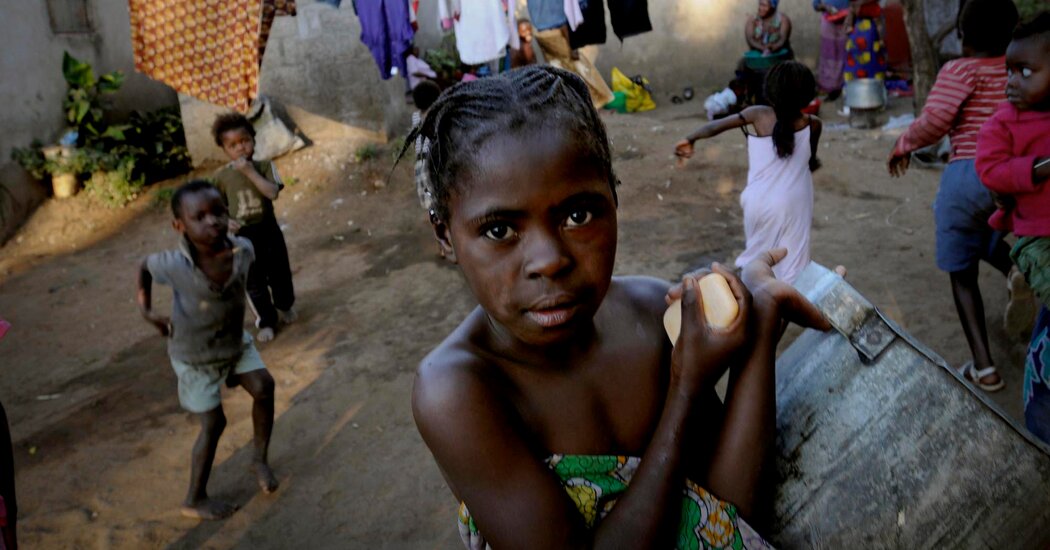WALKING THE BOWL
A True Story of Murder and Survival Among the Street Children of Lusaka
By Chris Lockhart and Daniel Mulilo Chama
In the first pages of “Walking the Bowl,” a vibrant account of the lives of street children in Lusaka, Zambia, 11-year-old Lusabilo comes across the corpse of a younger boy protruding from a mountain of trash. The body is dangling upside down, two holes gaping where his eyes had been.
A number of reactions might seem appropriate here: horror, pity, a scramble to seek help from someone with authority. But Lusabilo, our main character, exhibits none of these responses. He cocks his head to one side and closely examines the body, trying to situate it in the universe of the street.
Was the dead child, who comes to be known as “the Ho Ho Kid,” one of the beggar boys, deployed by ruthless adolescent ringleaders in exchange for the mind-obliterating relief of cobbler’s glue? Or was he a trash-sorter like Lusabilo, accepting the toxic conditions of the dump in return for a sliver of autonomy? Or was he something more slippery, a child without a guild?
And what exactly, Lusabilo wonders, would this death mean in the ever-shifting equation between the street children and the police, the chief representatives of the adult world in their lives?
It is hard to believe that rules exist in a society where children are treated as disposable goods. In many cities, they are sent out to beg at intersections, starved and filthy, while well-fed grown-ups glide past — I was one, for the years I spent in Delhi. And these children are not orphans, we learn: Their families have sent them out here to earn, in the full knowledge that they are likely to be raped or otherwise exploited.
Street children learn the rules of the undercity, because they have to. They are survival machines. In “Walking the Bowl,” Chris Lockhart, an American anthropologist, and Daniel Mulilo Chama, a Zambian outreach worker, allow us to slip inside this world as effortlessly as one might slip into a swimming pool.
There have been other novelistic nonfiction narratives about the daily lives of the urban poor, notably Katherine Boo’s 2012 book, “Behind the Beautiful Forevers: Life, Death, and Hope in a Mumbai Undercity.” But daily life, meticulously recorded, rarely has the attributes of a novel — a clean arc of ascending action, a handful of vivid characters, an ending that snaps shut like a purse.
“Walking the Bowl,” remarkably, has all of those. After the first, jarring encounter with a child’s corpse, we meet our main characters: a 17-year-old hustler who has heaved himself out of the violent ditch of his childhood; a spindly 8-year-old sent by bus to Lusaka, only to disembark and discover that he is completely alone; a 16-year-old prostitute, scrubbing off the scent of her customers and planning her escape; and Lusabilo, the scavenger who observes everything.
Their lives twine around one another; each, it turns out, has played a key role in the Ho Ho Kid’s death. By the end of the story, one will be ruined, one will be rescued and two will attempt a dazzling, unlikely escape. But to learn this, as in any detective novel, the reader must be patient, settling into the rhythm of the back streets of Lusaka.
“Walking the Bowl” began as a more traditional work of anthropology. Lockhart and Chama met at a conference in 2011, and discovered that they shared a frustration: that in the reams of literature about street children, there was little that captured their daily experience.
The two constructed a formidable information-gathering network, recruiting and training five former street children and a graduate student — they are not credited by name in the book, out of concern for their safety — to shadow subjects in the field for several days and nights every week. Their notes were fed into a treasury of information, raw material for an anatomy of Lusaka’s street life.
Two years into this process, the child’s body turned up, and the authors pivoted sharply. The death of a street child is not a rare event in Lusaka — that same week, the bodies of a dozen unidentified 8-year-old boys were brought into the mortuary — but in this case, the team swiftly realized, the police were laser-focused on finding the boy’s killer.
So Lockhart and Chama redeployed their researchers to closely chronicle the murder investigation, paring away their vast material until what remained was a fluid, elegant crime story, without an ounce of excess, all the more powerful because it is true.
There is a built-in problem to nonfiction that reads like fiction. At times, the language of “Walking the Bowl” is so literary that I found myself wondering how much of it came from precise observation. It narrates the unspoken thoughts of its subjects in poetic, abstract terms: A man’s skin growths are described as “living, breathing tumors, slowly transforming their host’s face from human to plant”; a hilly landscape “seemed to swell and bloat like hippos in shallow water.” Its characters deliver long speeches — early on, in a conversation with a drug dealer, a criminal kingpin philosophizes on police corruption for 27 sentences. Was that recorded?
In explanatory notes, Lockhart and Chama say that 85 percent of the incidents described in the book were “directly observed by a team member,” and that around 75 percent of quotations were captured with an audio recorder. The remainder was reconstructed through interviews. Still, I had an unsettling sense, at times, that I was hearing a writer’s imagination at work.
Lockhart and Chama insert themselves into the story as unnamed, secondary characters. Chama is the idealistic “Outreacher,” trying doggedly, sometimes wistfully, to break through the street kids’ hard shells. Immersed in this bleak world of tiny beggars and prostitutes, he believes passionately in the power of small good deeds. Lockhart is “the white man,” a jaded veteran of the NGO and development world, skeptical of happy endings. In a roadside bar, the two friends debate whether individual acts of generosity can add up to anything in such a hopeless place.
By the end of the book, it is clear who won the argument. “Walking the Bowl” describes layer upon layer of moral disaster. Elites grow wealthy while most of the population remains desperately poor. And NGO workers live in their own self-congratulatory world, feeding off a river of international aid and comparing notes on desperate children.
After laying all that out, “Walking the Bowl” opts to steer away from argument or analysis. Instead, in the margins of a detective story, it evokes a world in its entirety: the fleshy, sticky smell of a subtropical bus station, the grimy windows and dark hallways of a police precinct. It shows how fluctuations in the price of oil reverberate, reaching the lives of the world’s most vulnerable people. Its pages vibrate with life.
Most of all, it tells the story of children who, under impossible circumstances, manage to survive. Their voices are not always what we expect. After finding the child’s body, Lusabilo surveys the mountains of trash that surround it with a kind of jaunty practicality. “They relied on one another to make it all work, to maintain invisible boundaries and unspoken norms,” the narrator says of the scavenger children.
He does not see himself as inferior, because he knows that the smaller kids in the dump look up to him. He’s proud to be part of a network, even a network of “scrawny worker bees with twig arms and burned-out bodies.” They may be poor, Lusabilo tells us, but they have a community. And a person who has a community is not lost.


























